Soil
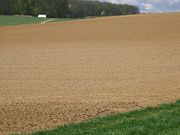
Soil is the naturally occurring, unconsolidated or loose covering on the Earth's surface. Soil is made up of broken rock particles that have been altered by chemical and environmental conditions, affected by processes such as weathering and erosion. Soil is different from its parent rock(s) source(s), altered by interactions between the lithosphere, hydrosphere, atmosphere, and the biosphere.[1] It is a mixture of mineral and organic constituents that are in solid, gaseous and aqueous states.[2][3] Soil particles pack loosely, forming a soil structure filled with pore spaces. These pores contain soil solution (liquid) and air (gas).[4] Accordingly, soils are often treated as a three state system.[5] Most soils have a density between 1 and 2, and weigh between 60 and 120 pounds per cubic foot. [6] Soil is also known as earth: it is the substance from which our planet takes its name.
Contents |
Characteristics
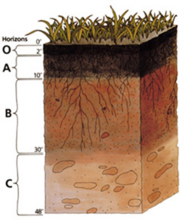
Soil color is the first impression one has when viewing soil. Striking colors and contrasting patterns are especially memorable. The Red River in Louisiana carries sediment eroded from extensive reddish soils like Port Silt Loam in Oklahoma. Soil color results from chemical and biological weathering. As the primary minerals in parent material weather, the elements combine into new and colorful compounds. Iron forms secondary minerals with a yellow or red color; organic matter decomposes into brown compounds; and manganese, sulfur and nitrogen can form black mineral deposits.[7]
Soil structure is the arrangement of soil particles into aggregates. These may have various shapes, sizes and degrees of development or expression.[8]
Soil texture refers to sand, silt and clay composition. Sand and silt are the product of physical weathering while soil is the product of chemical weathering. Soil content is particularly influential on soil behavior due to a high retention capacity for nutrients and water.[9]
The electrical resistivity of soil can affect the rate of galvanic corrosion of metallic structures in contact with it. Higher moister content or increased electrolyte concentration can lower the resistivity and thereby increase the rate of corrosion.[10] Soil resistivity values typically range from about 2 to 1000 Ω·m, but more extreme values are not unusual.[11]
Formation
Soil formation, or pedogenesis, is the combined effect of physical, chemical, biological, and anthropogenic processes on soil parent material resulting in the formation of soil horizons. Soil is always changing. The long periods over which change occurs and the multiple influences of change mean that simple soils are rare. While soil can achieve relative stability in properties for extended periods of time, the soil life cycle ultimately ends in soil conditions that leave it vulnerable to erosion. Little of the soil composition of the earth is older than Tertiary and most no older than Pleistocene.[12] Despite the inevitability of soils retrogression and degradation, most soil cycles are long and productive. How the soil "life" cycle proceeds is influenced by at least five classic soil forming factors: regional climate, biotic potential, topography, parent material, and the passage of time. An example of soil development from bare rock occurs on recent lava flows in warm regions under heavy and very frequent rainfall. In such climates plants become established very quickly on basaltic lava, even though there is very little organic material. The plants are supported by the porous rock becoming filled with nutrient bearing water, for example carrying dissolved bird droppings or guano. The developing plant roots themselves gradually break up the porous lava and organic matter soon accumulates. But even before it does, the predominantly porous broken lava in which the plant roots grow can be considered a soil.
Organic matter
Most living things found in soils, including plants, insects, bacteria and fungi, are dependent on organic matter for nutrients and energy. Soils often have varying degrees of organic compounds in different states of decomposition. Many soils, including desert and rocky-gravel soils, have no or little organic matter; while soils, such as peat (Histosols), that are all organic matter are infertile.[13]
Humus
Humus refers to organic matter that has decomposed to a point were it is resistant to further breakdown or alteration. Humus typically forms from plant residues like foliage, stems and roots. After death, these plant residues begin to decay, starting the formation of humus. Humus formation involves changes within the soil and plant residue, there is a reduction of water soluble constituents including cellulose and hemicellulose; as the residues are deposited and break down, lignin and lignin complexes accumulate within the soil; as microorganisms live and feed on the decaying plant matter, an increase in proteins occurs.
Lignin is resistant to breakdown and accumulates within the soil, it also chemically reacts with amino acids which add to its resistance to decomposition, including enzymatic decomposition by microbes. Fats and waxes from plant matter have some resistance to decomposition and persist in soils for a while. Proteins normally decompose readily but when bound to clay particles they become more resistant to decomposition, clay particles also absorb enzymes that would break down proteins, thus clay soils often have higher organic contents that persist longer than soils without clay. The addition of organic matter to clay soils, can render the organic matter and any added nutrients inaccessible to plants and microbes for many years, since they can bind strongly to the clay.
Humus formation is a processes dependent on the amount of plant material added each year and the type of base soil; both are effected by climate and the type of microorganisms present. Soils with humus can vary in nitrogen content but have 3 to 6 percent nitrogen typically; humus as a reserve of nitrogen and phosphorus, is a vital component effecting soil fertility.[13] Humus also adsorbs water, acting as a moisture reserve, that plants can utilize; it also expands and shrinks between dry and wet states, providing pore spaces. Humus is less stable than other soil constituents, because it is effected by microbial decomposition, and over time its concentration decreases without the addition of new organic matter.
Climate and organics
The production and accumulation, or degradation, of organic matter and humus is greatly depended on climate conditions. Temperature and soil moisture are major factors in the formation or degradation of humus and the formation of organic soils. Soils high in organic matter tend to form under wet conditions and/or were there is enough precipitation to sustain thick vegetation.
In nature
Biogeography is the study of special variations in biological communities. Soils are restricting factor as to what plants can grow in which environments. Soil scientists survey soils in the hope of understanding controls as to what vegetation can and will grow in a particular location
Geologists also have a particular interest in the patterns of soil on the surface of the earth. Soil texture, color and chemistry often reflect the underlying geologic parent material and soil types often change at geologic unit boundaries. Buried paleosols mark previous land surfaces and record climatic conditions from previous eras. Geologists use this paleopedological record to understand the ecological relationships in past ecosystems. According to the theory of biorhexistasy, prolonged conditions conducive to forming deep, weathered soils result in increasing ocean salinity and the formation of limestone.
Geologists use soil profile features to establish the duration of surface stability in the context of geologic faults or slope stability. An offset subsoil horizon indicates rupture during soil formation and the degree of subsequent subsoil formation is relied upon to establish time since rupture.
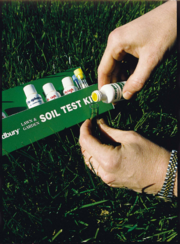
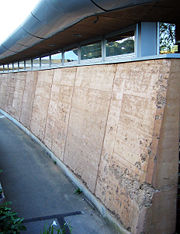
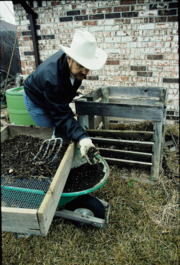
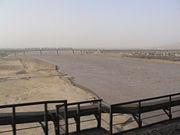
Soil examined in shovel test pits is used by archaeologists for relative dating based on stratigraphy (as opposed to absolute dating). What is considered most typical is to use soil profile features to determine the maximum reasonable pit depth than needs to be examined for archaeological evidence in the interest of cultural resources management. Terra preta do Indio.
Soils altered or formed by man (anthropic and anthropogenic soils) are also of interest to archaeologists.
Uses
Soil is used in agriculture, where it serves as the primary nutrient base for the plants. The types of soil used in agriculture (among other things, such as the purported level of moisture in the soil) vary with respect to the species of plants that are cultivated.
Soil material is a critical component in the mining and construction industries. Soil serves as a foundation for most construction projects. Massive volumes of soil can be involved in surface mining, road building, and dam construction. Earth sheltering is the architectural practice of using soil for external thermal mass against building walls.
Soil resources are critical to the environment, as well as to food and fiber production. Soil provides minerals and water to plants. Soil absorbs rainwater and releases it later thus preventing floods and drought. Soil cleans the water as it percolates. Soil is the habitat for many organisms.
Waste management often has a soil component. Septic drain fields treat septic tank effluent using aerobic soil processes. Landfills use soil for daily cover.
Organic soils, especially peat, serve as a significant fuel resource.
Both humans in many cultures and animals occasionally eat soil.
Soils play an important role in filtrating and purifying water. After coming down as precipitation, much of the rain water is percolated through the many horizons of a soil profile and renamed as groundwater. As the water moves through different areas such as wetlands, forests, and riparian zones many pollutants are removed. Pollutants such as viruses, oils, metals, excess nutrients, and sediments are filtered out by the soil and surrounding organisms.
Riparian zones act as living filters which absorb and take in excess nutrients and pollutants brought in from runoff, rainfall, and surrounding areas. These natural filtration systems are important in purifying our drinking water as much as possible before it reaches treatment plants to reduce the cost of that treatment and to minimize the amount of chemicals added in order to make it drinkable.[14]
Degradation
Land degradation is a human induced or natural process which impairs the capacity of land to function. Soils are the critical component in land degradation when it involves acidification, contamination, desertification, erosion, or salination.
While soil acidification of alkaline soils is beneficial, it degrades land when soil acidity lowers crop productivity and increases soil vulnerability to contamination and erosion. Soils are often initially acid because their parent materials were acid and initially low in the basic cations (calcium, magnesium, potassium, and sodium). Acidification occurs when these elements are removed from the soil profile by normal rainfall or the harvesting of crops. Soil acidification is accelerated by the use of acid-forming nitrogenous fertilizers and by the effects of acid precipitation.
Soil contamination at low levels are often within soil capacity to treat and assimilate. Many waste treatment processes rely on this treatment capacity. Exceeding treatment capacity can damage soil biota and limit soil function. Derelict soils occur where industrial contamination or other development activity damages the soil to such a degree that the land cannot be used safely or productively. Remediation of derelict soil uses principles of geology, physics, chemistry, and biology to degrade, attenuate, isolate, or remove soil contaminants and to restore soil functions and values. Techniques include leaching, air sparging, chemical amendments, phytoremediation, bioremediation, and natural attenuation.
Desertification is an environmental process of ecosystem degradation in arid and semi-arid regions, or as a result of human activity. It is a common misconception that droughts cause desertification. Droughts are common in arid and semiarid lands. Well-managed lands can recover from drought when the rains return. Soil management tools include maintaining soil nutrient and organic matter levels, reduced tillage and increased cover. These help to control erosion and maintain productivity during periods when moisture is available. Continued land abuse during droughts, however, increases land degradation. Increased population and livestock pressure on marginal lands accelerates desertification.
Soil erosional loss is caused by wind, water, ice, movement in response to gravity. Although the processes may be simultaneous, erosion is distinguished from weathering. Erosion is an intrinsic natural process, but in many places it is increased by human land use. Poor land use practices include deforestation, overgrazing, and improper construction activity. Improved management can limit erosion using techniques like limiting disturbance during construction, avoiding construction during erosion prone periods, intercepting runoff, terrace-building, use of erosion suppressing cover materials and planting trees or other soil binding plants.
A serious and long-running water erosion problem is in China, on the middle reaches of the Yellow River and the upper reaches of the Yangtze River. From the Yellow River, over 1.6 billion tons of sediment flow each year into the ocean. The sediment originates primarily from water erosion (Gully erosion) in the Loess Plateau region of northwest China.
Soil piping is a particular form of soil erosion that occurs below the soil surface. It is associated with levee and dam failure as well as sink hole formation. Turbulent flow removes soil starting from the mouth of the seep flow and subsoil erosion advances upgradient.[15] The term sand boil is used to describe the appearance of the discharging end of an active soil pipe.[16]
Soil salination is the accumulation of free salts to such an extent that it leads to degradation of soils and vegetation. Consequences include corrosion damage, reduced plant growth, erosion due to loss of plant cover and soil structure, and water quality problems due to sedimentation. Salination occurs due to a combination of natural and human caused processes. Aridic conditions favor salt accumulation. This is especially apparent when soil parent material is saline. Irrigation of arid lands is especially problematic. All irrigation water has some level of salinity. Irrigation, especially when it involves leakage from canals, often raise the underlying water table. Rapid salination occurs when the land surface is within the capillary fringe of saline groundwater. Salinity control involves flushing with higher levels of applied water in combination with tile drainage.[17]
See also
- Geohumus
- Geoponic
- Humus
- Manure
- Mud
- Nitrogen cycle
- Red Mediterranean soil
- Soil contamination
- Soil erosion
- Soil functions
- Soil mechanics
- Shrink-swell capacity
References
- ↑ Chesworth, Edited by Ward (2008), Encyclopedia of soil science, Dordrecht, Netherland: Springer, xxiv, ISBN 1402039948
- ↑ Voroney, R. P., 2006. The Soil Habitat in Soil Microbiology, Ecology and Biochemistry, Eldor A. Paul ed. ISBN=0125468075
- ↑ James A. Danoff-Burg, Columbia University The Terrestrial Influence: Geology and Soils
- ↑ Taylor, S. A., and G. L. Ashcroft. 1972. Physical Edaphology
- ↑ McCarty, David. 1982. Essentials of Soil Mechanics and Foundations
- ↑ Bulk Density Determination
- ↑ "The Color of Soil". United States Department of Agriculture - Natural Resources Conservation Service. Retrieved on 2008-07-08.
- ↑ Soil Survey Division Staff (1993). "Soil Structure". Handbook 18. Soil survey manual. Retrieved on 2008-07-08.
- ↑ R. B. Brown (September 2003). "Soil Texture". Fact Sheet SL-29. University of Florida, Institute of Food and Agricultural Sciences. Retrieved on 2008-07-08.
- ↑ "Electrical Design, Cathodic Protection". United States Army Corps of Engineers (1985-04-22). Retrieved on 2008-07-02.
- ↑ R. J. Edwards (1998-02-15). "Typical Soil Characteristics of Various Terrains". Retrieved on 2008-07-02.
- ↑ Buol, S. W.; Hole, F. D. and McCracken, R. J. (1973). Soil Genesis and Classification (First ed.). Ames, IA: Iowa State University Press. ISBN 0-8138-1460-X..
- ↑ 13.0 13.1 Foth, Henry D. (1984), Fundamentals of soil science, New York: Wiley, pp. 151, ISBN 0471889261
- ↑ http://www.esa.org/ecoservices/comm/body.comm.fact.wate.html
- ↑ Jones, J. A. A. (1976). "Soil piping and stream channel initiation". Water Resources Research 7 (3): 602–610. doi:.
- ↑ Dooley, Alan (June, 2006). "Sandboils 101: Corps has experience dealing with common flood danger". US Army Corps of Engineers. Retrieved on 2008-05-14.
- ↑ Drainage Manual: A Guide to Integrating Plant, Soil, and Water Relationships for Drainage of Irrigated Lands. Interior Dept., Bureau of Reclamation. 1993. ISBN 0-16-061623-9.
Further reading
- Adams, J.A. 1986. Dirt. College Station, Texas : Texas A&M University Press ISBN 0890963010
- Soil Survey Staff. (1975) Soil Taxonomy: A basic system of soil classification for making and interpreting soil surveys. USDA-SCS Agric. Handb. 436. U.S. Gov. Print. Office. Washington, DC.
- Soil Survey Division Staff. (1999) Soil survey manual. Soil Conservation Service. U.S. Department of Agriculture Handbook 18.
- Logan, W. B., Dirt: The ecstatic skin of the earth. 1995 ISBN 1-57322-004-3
- Faulkner, William. Plowman's Folly. New York, Grosset & Dunlap. 1943. ISBN 0-933280-51-3
- Jenny, Hans, Factors of Soil Formation: A System of Quantitative Pedology 1941
- Why Study Soils?
- Soil notes
- "97 Flood". USGS. Retrieved on 2008-07-08. Photographs of sand boils.
- Oregon State University's Soils (wiki)
- Soil-Net.com A free schools-age educational site teaching about soil and its importance.
- LandIS Soils Data for England and Wales a pay source for GIS data on the soils of England and Wales and soils data source; they charge a handling fee to researchers.
- LandIS Free Soilscapes Viewer Free interactive viewer for the Soils of England and Wales
- Geo-technological Research Paper, IIT Kanpur, Dr P P Vitkar - Strip footing on weak clay stabilized with a granular pile http://rparticle.web-p.cisti.nrc.ca/rparticle/AbstractTemplateServlet?journal=cgj&volume=15&year=1978&issue=4&msno=t78-066&calyLang=eng
- Mann, Charles C.: " Our good earth" National Geographic Magazine September 2008
External links
- Soil Science Society of America
- Percolation Test Learn about Soil, Percolation, Perc and Perk Tests.
- USDA-NRCS Web Soil Survey Inventory of the soil resource across the U.S.
- European Soil Portal EUSOILS (wiki)
- Wossac the world soil survey archive and catalogue.
|
||||||||||||||||||||||||||||||||||||||